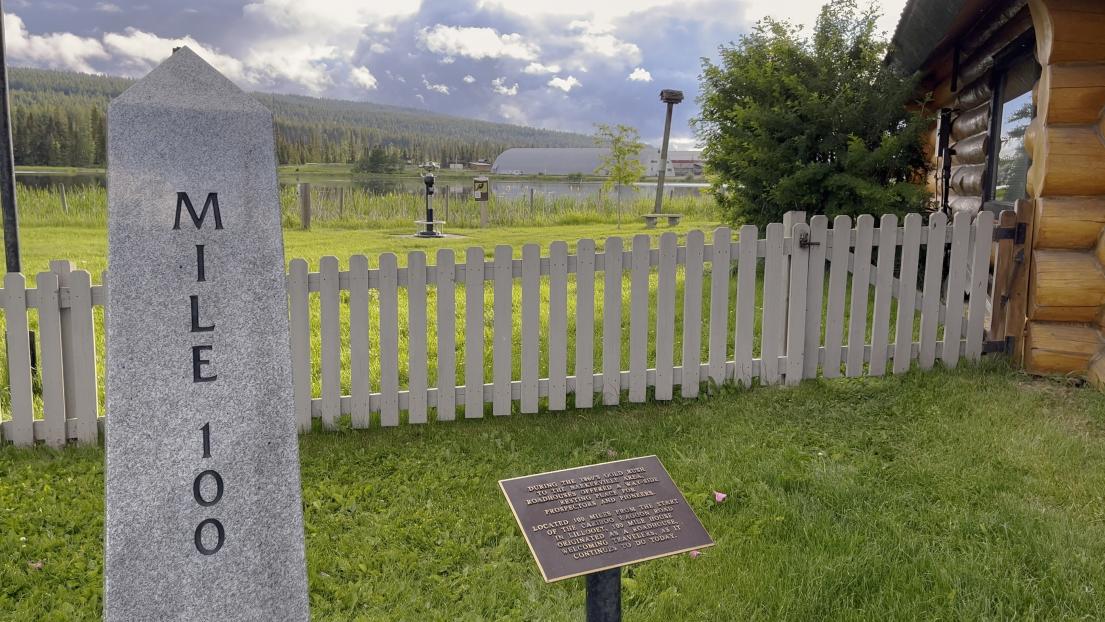100 Miles From Where?
Why Is It Called 100 Mile House?
The name dates back to the 1860s and marks its location exactly 100 miles from Lillooet, the starting point of the historic Cariboo Waggon Road — a grueling 300-mile journey to the Barkerville gold fields.
This spot became a key stopover for those heading to the gold rush. While many were miners and prospectors chasing fortune, others came with different ambitions. Blacksmiths, surveyors, accountants, ranchers, and various entrepreneurs all followed the Gold Rush Trail, hoping to make their own mark and profit along the way.
Located along Hwy. 97, you will find the 108 Heritage Site. Tourists and locals are welcome year-round. The site is open for daily tours mid-May to September.
While most of the buildings are original to the site, a few have been moved to the location including the McNeil House, the Greenlees trapper’s cabin and the 133 Mile School House. The McNeil House was once located at 105 Mile and was one of the original roadhouses. Fashioned in the classical Victorian style, the house boasted 10 bedrooms. It ceased to be a roadhouse in 1912 and is now home to a most interesting museum.
Other buildings at the 108 Heritage Site include the impressive Watson Barn, the BX barn, a blacksmith shop, post house, icehouse, school house, church, telegraph building, bunk house, an outhouse and the Ainsworth sawmill display.
Scattered along the Cariboo Gold Rush Trail are a series of roadhouses. Usually within a day’s ride of each other, the roadhouses were most often built where water and grasslands were plentiful. Those on the way to the gold fields to the north stopped overnight for a meal, a bed and a place to water and feed their horses. Road contractors or those who did not fare so well in the gold fields were often responsible for building the stopping houses. They in turn became the pioneers of the area and developed communities and local businesses.
In 1863, the road from Yale north to Soda Creek was completed; by 1864, coaches, mule trains and freight wagons were moving passengers and supplies along the 480 km route, a 52-hour voyage. The Barnard Express Stage line, whose coaches regularly travelled this road, used several vehicles, such as mail coaches and six-horse passenger coaches. These coaches travelled up and down the Cariboo for 50 years until 1915, the end of the stagecoach era. The South Cariboo Visitor Centre, 100 Mile House is the resting-place for one of the few surviving wagons of the Barnard Express Stage Line
The discovery of gold on the Horsefly River by Peter Dunlevy in 1859 started the Cariboo Gold Rush. Bridge Creek House, which was 100 miles from the jumping-off place on the route to fortune, was renamed 100 Mile House. Successive owners catered to the travelers and settlers who were seeking to carve their own niche in the “Cariboo.” In 1912, one of the owners was killed in a hunting accident, leading to the sale of 100 Mile House Ranch and Roadhouse. By that time, it was composed of five adjoining buildings, which had been added onto as time and funds allowed. Sold to the Marquis of Exeter, a house was built for his son, Lord Martin Cecil, who arrived from England to take up residency. In 1937, the original five buildings caught fire and the building with its sixteen bedrooms burned to the ground.
Beautiful 100 Mile House, BC
Pathway to Gold: A Guide for Travellers to the Cariboo Waggon Road is now available online on the New Pathways to Gold Society website in three chapters. The three PDFs cover the CWR route from Lillooet to 150 Mile. Newman weaves a rich narrative of stories along the road, including Indigenous, Fur Trade, Gold Rush and contemporary tales. "This really was a labour of love and went way beyond what I thought it would encompass,” says Newman, Cariboo Waggon Road Restoration Project Assistant. “To be able to capture some of the incredible narrative of this route, from Indigenous memories to the Gold Rush to right now, down to seeing the birds and flowers and wildlife along this spectacular route was a transformative experience.” The guide is an invaluable online resource that can also be printed off by hikers, cyclists and others. With further funding, the guide will be extended all the way to Barkerville. Pathway to Gold has been produced as part of the Cariboo Waggon Road Restoration Project (CWRRP), a partnership between the New Pathways to Gold Society (NPTGS), Cariboo Regional District, District of 100 Mile House, Village of Clinton, BC Parks, Ministry of Transportation and Infrastructure and the Outdoor Recreation Council of BC. “We hope people will enjoy the incredible visitor experience along this route in a safe, responsible manner and we know this lays the groundwork for restoring this iconic heritage transportation route as well as articulating its history in the post-pandemic era.” The project has identified eleven priority sections from Clinton to Barkerville that can be restored and interpreted to give visitors from B.C. and elsewhere unique experiences.

